 |
 The Happy Daylily Blog - daylily pictures and thoughts from my garden
The Happy Daylily Blog - daylily pictures and thoughts from my garden

|
 August 29th, 2022 August 29th, 2022 |
I have used humate in my garden for years but always used a concentrate which is diluted with water and then applied as a soil drench. This fall, because I'll be doing a lot of transplanting, I've decided to use a granular form which can be incorporated into the soil during the planting process. I found an on-line source to buy a 50 lb bag of all natural (mined) humate and have ordered some. I probably won't use the full 50 lbs but as it can be stored indefinately as long as it remains dry I can use the remainder for future transplanting.
Last year I heard that one of the best things I could do for the lawn was to spread leaf mould compost in the fall. I tried it and my lawn responded well including filling in dead spots after last summer's huge infestation of chinch bugs. I was thinking of treating both the front and back lawns this fall but the thought of thinly spreading a whole yard of this gardener's gold one shovel full at a time was daunting (not to mention the two 30 mile round trips to buy the compost). So I decided to try applying granular humate (can be done with a fertilizer spreader) and watering it in with some soil microbes. This will hopefully provide a similar stimulus to the lawn and save many hours of work.
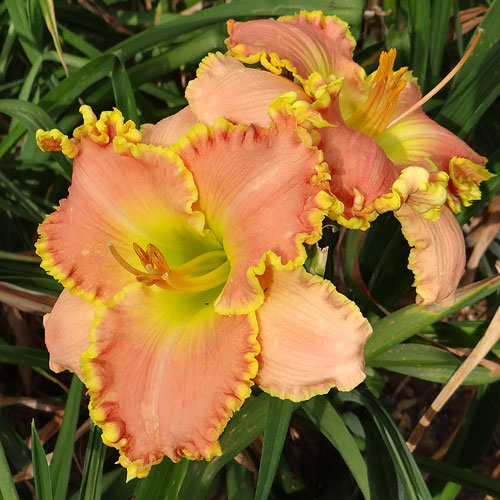
Seedling 13-096
Seedling 13-096 has 6" blooms on 29" scapes and comes from the cross ((Sherry Lane Carr x Larry Grace) X Steve Martin).
|
 August 25th, 2022 August 25th, 2022 |
With fall right around the corner, it's time to take stock of my fall gardening supplies. I want to make sure I get everything I'll need for fall while the weather is still too hot to enjoy being outside. Once I finish my 'needs and wants' list, I'll first do an online search so I can establish a cost baseline. Then I visit my local sources to see what they have to offer. While price can be somewhat of a factor, I like to purchase locally wherever possible to support the local retailers. Only if I can't locate what I want locally or if the local price is way out of line, I'll order from online sources.
Fertilizer is one of the items I'll be looking to purchase. I checked and local prices for the Osmocote time-release fertilizer I've been using are almost two and a half times the price since my last purchase. Nitro-phos 15-5-10 looks to be about 1/3 the cost of Osmocote so that's probably what I'll be going with. I've used Nitro-phos fertilizer on my lawn for years.
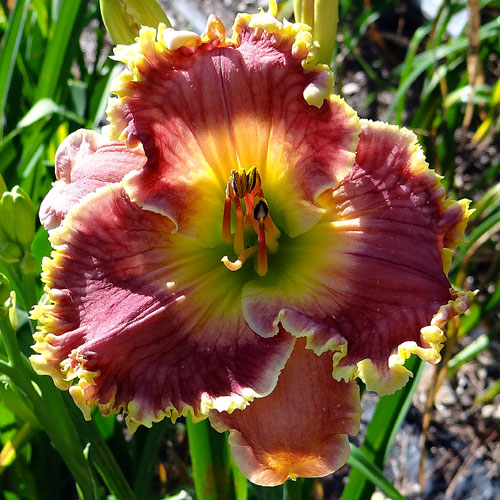
Seedling 13-102
This year seedling 13-102 had it's best bloom since back in 2013 (the first year it bloomed). It was going to be on the chopping block this fall but perhaps it has redeemed itself for another year. It has 6" blooms on 34" scapes and comes from the cross (Moonlight Sail X Violet Becomes You).
|
 August 19th, 2022 August 19th, 2022 |
I had planned to give the daylilies a light fertilization in early July to help them recover from the stress of blooming but I didn't do that this year. The July heat wave was pushing the daylilies to drop much of the remaining spring foliage to protect the plants from excessive moisture loss through leaf transpiration. Ferilizer tends to promote new foliage growth and I thought the two competing factors could be counter productive. It's too late now so I'll just wait until next month when I normally do the fall feeding.
Fertilizer prices have skyrocketed so unless I find an unexpected bargain, I'll probably fertilizer with a 15-5-10 or 13-13-13 this fall instead of time release fertilizer. The time release allows for a single application but the granular will require applying a couple of times this fall to provide the same results.
With temperatures now firmly back in the 90's, some of the daylilies starting to put on new fans. This increase is always welcome as the additional fans means more scapes in the future.

Seedling 16-091
Seedling 16-091 has 6.5" blooms on 30" scapes and comes from the cross (What Love Can Do X Sarah Starchak).
|
 August 12th, 2022 August 12th, 2022 |
3/4 inch of rain resulted in slightly lower morning temperatures so I got to work yesterday removing dried scapes from the back yard beds. My last post indicated at least a couple of hundred baby toads hopping around but after spending a couple of hours in the yard, that estimate was greatly understated. There could be thousands of them. As I walked through the grass, they would scatter before me kind of like walking through a field filled with grasshoppers. Currently the anole lizards are eating their fill but soon the toadlets will be too large to eat. I also saw a small bird eating one but there are still very few native birds in the neighborhood. They were either scared away or captured by the two families of Cooper's Hawks that up until recently resided in nearby oak trees. Nevertheless, most of these baby toads will probably never reach adulthood.
Daylilies continue to put on new foliage. Hopefully we won't have another heat wave like in July.
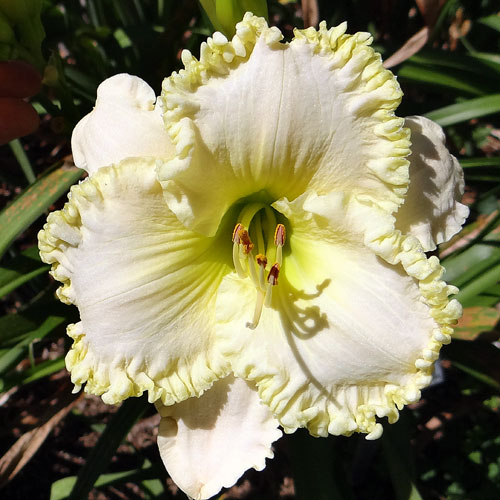
Seedling 16-107
Today's seedling is 16-107. It has 6" blooms on 27" scapes and comes from the cross (Elegant Expressions X Fringy).
|
 August 10th, 2022 August 10th, 2022 |
Recently there has been an explosion of 1/2" toadlets hopping around every corner of my yard. I've seen them from the front lawn by the street all the way to the backyard fence. I've seen a couple of hundred at least. They are fast hoppers so I can't get very close but they appear to be Gulf Coast toads. Gulf Coast toads are one of the more common toads in this area. After looking around the yard I think I found the source. The A/C condensate drain pipe was not properly installed and there's always been a wet spot where the condensate drips out when the A/C runs. There are dozens within a few feet of this wet spot. The A/C has dripped here for over 15 years but this is the first time I've seen these toadlets.
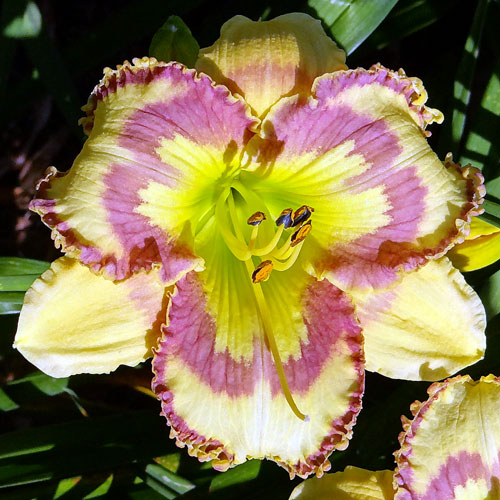
Seedling 16-004
Seedling 16-004 has 5.5" blooms on 20" scapes. It comes from the cross (Violet Stained Glass X Serengeti Sunrise). Bud count is quite underwhelming but it makes a nice, albiet short show in the garden.
|
 August 7th, 2022 August 7th, 2022 |
I've always had a problem with mosquitos. Some years it's been so bad that just walking through the daylily beds early in the morning stirs up literally clouds of the biters. Mosquitos lay their eggs in water and while I try to prevent any standing water, even wet ground can be enough for a new generation to be hatched and of course, I like to keep my daylilies watered. This year, I decided to try something that I saw on YouTube. I made DIY 'mosquito traps'.
I placed a number of 5-gallon buckets in out of the way places near where that mosquitos are apt to hunker down during the day. 5-gal is way larger than needed but I already had some that I could use. I then filled the buckets about 1/3 full of water. I purchased a product called "Mosquito Dunks" and put a half a dunk in each bucket. Mosquito dunks have been used for years by farmers to suppress mosquitos in stock tanks, ponds, bird baths, animal watering troughs, etc.. They contain bacillus thuringiensis which is harmless to people and animals but is toxic to mosquito larvae.
It doesn't kill the adult mosquitos but the water attracts them to a perfect place to lay their eggs and the mosquito larvae are killed thus reducing the overall mosquito population in the area. I also try to let the ground in the daylily beds dry out before I water again. This helps reduce the alternative sources of water which further drives them to the mosquito traps. The result has been a noticable reduction in mosquitos from previous years.
The only maintenance is to place fresh dunks in the buckets once a month but they are not expensive.
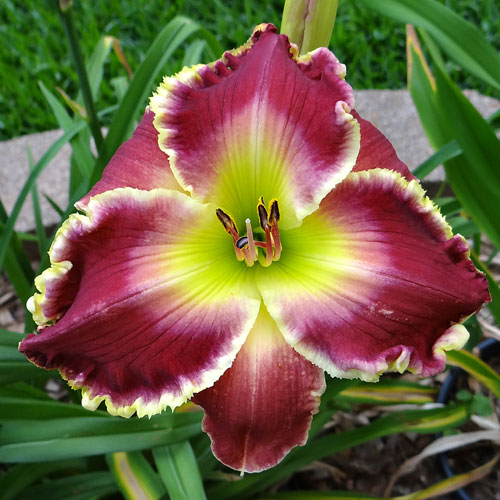
Seedling 16-033
Seedling 16-033 has 6" blooms on 26" scapes and comes from the cross (Cimarron Rose X Rose Sensation).
|
 August 5th, 2022 August 5th, 2022 |
There's really nothing to report on except that the summer drones on... and nobody wants to hear more about that (LOL). So I'm just going to post some pictures until I come across something to add.
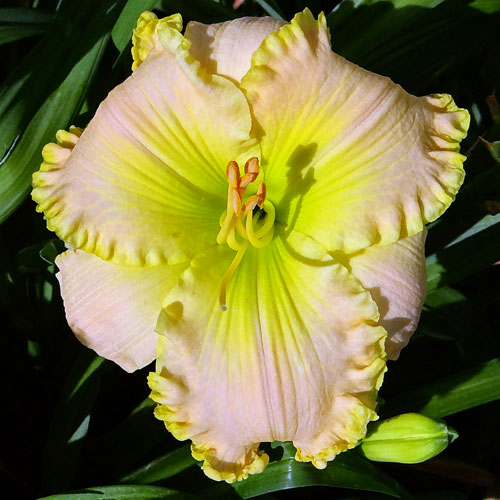
Seedling 13-056
Seedling 13-056 has 6" blooms on 24" scapes and comes from the cross (Carefree Sunset X Steve Martin). A wide yellow-green throat and heavily ruffled yellow-green edge on clear light pink petals earns it a spot in my garden. Unfortunately, all blooms don't open as well as the picture but that can be said for most daylilies.
|
 July 29th, 2022 July 29th, 2022 |
The heat wave has eased a bit with daily highs now in the upper 90's. Unfortunately we keep missing the rain showers and only about .1" of rain has fallen in the past 2 weeks.
The daylilies are coping for the most part. The foliage die-off has finished and there is even some new growth appearing on some cultivars. Gotta love the resiliency of daylilies.
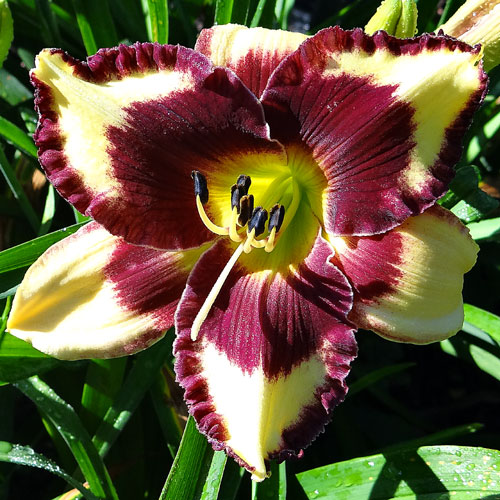
Seedling 14-005
Seedling 14-005 has 6" blooms on 30" scapes and comes from the cross (Hedwig's Eyes X Shipwreck Cove).
|
 July 23rd, 2022 July 23rd, 2022 |
There were scattered rain storms in and around Houston yesterday. Unfortunately, as Maxwell Smart used to say, they "missed me by that much!". So this morning I am setting up my sprinkler in the front yard to continued my twice a week watering schedule.
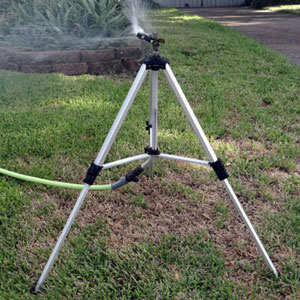
For years I fought the battle of trying to find the right sprinkler to water both the lawn and the daylilies. I tried oscillating sprinklers, rotary sprinklers, and impact sprinklers. While results were mixed, they all succeeded in watering the lawn but didn't work so well on the daylilies especially the larger beds in the back yard. The problem... they had to be placed at ground level so I couldn't place a sprinkler directly inside the beds. Then I read a post from another daylily grower who solved the problem using what they called a "rain tree". Today it's just called a tripod based sprinkler. I bought one and the daylily watering problem was solved. It works great on the lawn too. Oh, the dead spot on the lawn under the sprinkler is the result of chinch bugs that got ahead of me AGAIN this year (sigh...).
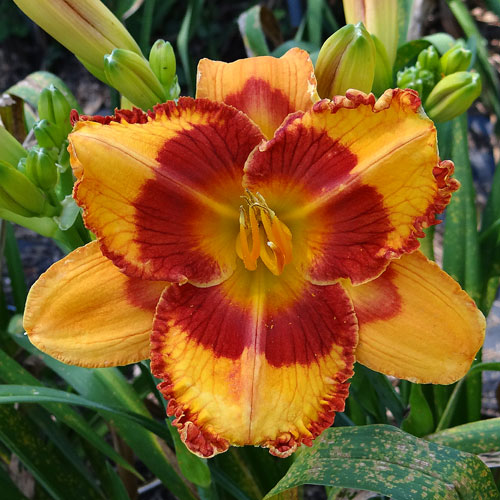
Seedling 13-069
Seedling 13-069 has 6" blooms on 28" scapes and comes from the cross (Orange City X Caribbean Magic).
|
 July 22nd, 2022 July 22nd, 2022 |
The long string of 100+ degree days is putting the hurt on the daylilies. There are a few cultivars that still have a decent amount of green foliage but many have significantly reduced foliage. There's also quite a number of cultivars that have gone into what many here in the deep south call 'summer dormancy'. These cultivars have had almost all the green foliage die off with only a small sprig of green foliage remaining above the surface similar to what many dormant cultivars do here in the winter.
I didn't see the first case of summer dormancy in my garden until around the year 2000. Interestingly enough, that year had a high number of 100 degree days according to our local TV weather guru. I saw the same thing in 2011 where every day in August except one was 100 degrees or higher. Now, it's happening again this year. It could be that the intense sun and high temperatures are quickly drying up the soil and the daylilies are dropping even more of their foliage to compensate for the lack of water.
I currently water the daylilies twice a week. Logic might say that this isn't enough and that's what's causing the summer dormancy and while this is probably true to some degree, there's a dark side to increasing watering during these high heat times. Years ago, I visited Ra Hansen's Florida garden in July and was amazed to find it lush and green with many blooms. When I left Houston, my garden was already done for the season with lots of brown foliage and few blooms. When asked how she kept her garden looking so good, she replied that she watered every evening. So I decided that I would do the same when I got back to Houston. Upon my return, I watered every other day for the rest of the summer. The result was pretty much a disaster. I lost a quarter of the daylilies in the garden that year due to crown rot. What I didn't know is that Ra had soil that had a high percentage of sand and drained incredibly quickly. My soil however had a high percentage of clay and silt and drained slowly. Watering every two days didn't give my soil a chance to dry out and this gave crown rot the perfect place to thrive.
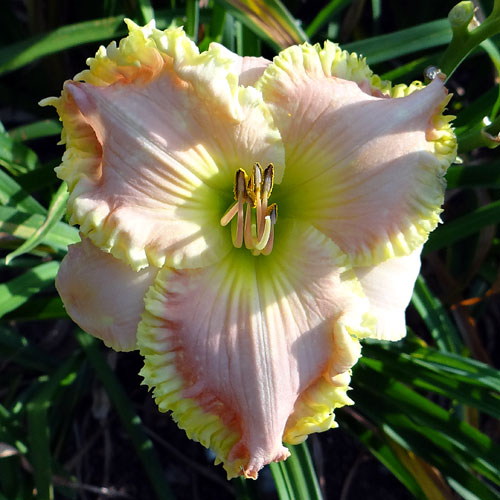
Seedling 16-050
Seedling 16-050 has 5.5" blooms on 27" scapes and comes from the cross (Celtic Moonglow X Rose Sensation).
|
 July 15th, 2022 July 15th, 2022 |
Humic acid thread continued...
The list of benefits of humic and fulvic acids are quite impressive. I've already mentioned that it increased water holding ability of the soil. Here are some other reported benefits - stimulates microbial activity, increased nutrient uptake, helps regulate pH of the soil, improves the overall soil structure, and improves overall plant health especially the roots.
It's also reported to help remove toxins from the soil. Years ago, I had over fertilized a bed which resulted in stunted growth because of the excess of phosphorus locked up in the soil. I read that humic acid would help and so I started using it. Over time, the soil responded and today seems to be back to normal.
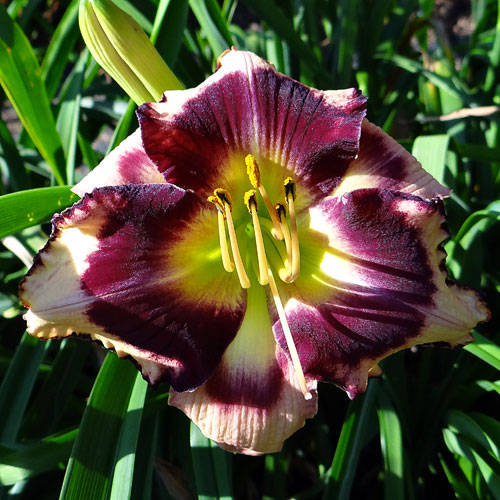
Seedling 15-006
Seedling 15-006 has a bud count in the low teens but remains in my garden for a couple of reasons. It has a pretty face and multiplies well allowing it to clump up fairly quickly. This allows it to put on a nice show despite its relatively low bud count. It has 6" blooms on 26" scapes and comes from the cross (Mississippi Memento X Thomas Tew).
|
 July 13th, 2022 July 13th, 2022 |
Humic acid thread continued...
Ancient wetlands built up large amounts of dead and decaying organic matter. Over time these massive deposits were covered by sand and rock and were compressed into rich deposits of humic. These deposits are mined and made into the various products available today.
The breakdown of organic matter into humus occurs naturally in our soil. Adding good compost to our gardens assists in this process. Unfortunately, the complete process can take a relatively long time and intensive farming or gardening can deplete soil of this valuable resource faster than it can be replaced. (to be continued...)
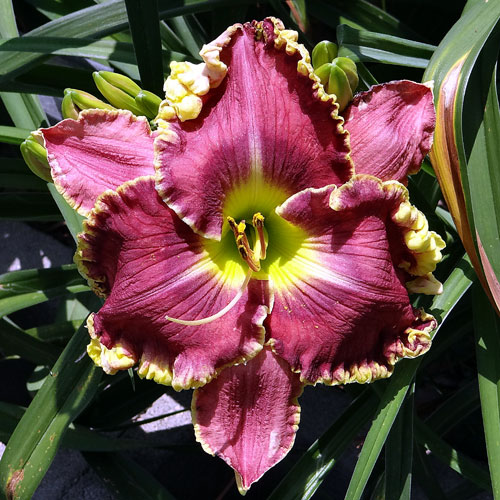
Seedling 14-025
Seedling 14-025 has 6" blooms on 25" scapes and comes from the cross (Cimarron Rose X Priscilla's Smile).
|
 July 10th, 2022 July 10th, 2022 |
A while back I posted about increasing the water holding ability of soil using humic acid (Humate). Today I'll be starting a series of posts about the humic and fulvic acids and their benefits to garden soils.
"Humic acid" is a broad term that refers to compounds that result from the complete breakdown of organic material. It exists naturally in soils, streams, and oceans all over the world. When plants and animals die, their organic material is broken down by organisms such as bacteria, fungi, protozoa, and earthworms. Eventually, some of the organic material is broken down into a material that resists further breakdown. This ending material is called humus. Humus consists of three components - humic acids, fulvic acids, and humin. The humic and fulvic acids have proven to be very beneficial for soil structure and aiding the transfer of nutrients between soil and plants. (to be continued...)
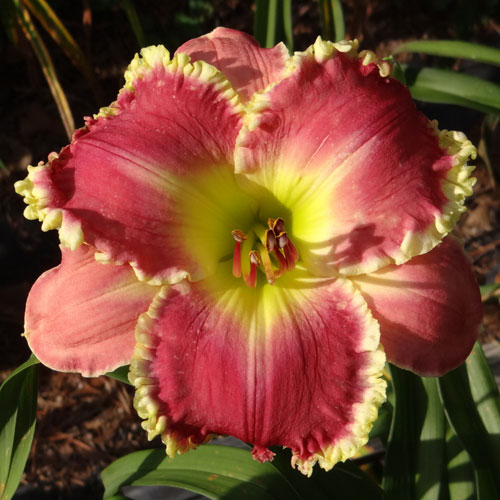
Seeding 16-034
Seedling 16-034 has 6" blooms on 26" scapes and comes from the cross (Rose Sensation X Magical Marrakech).
|
 July 6th, 2022 July 6th, 2022 |
I couldn't stand it any longer. The shed daylily foliage looked so bad that I've started cleaning the beds (at least the ones in the front yard). Removing all the completely brown foliage has done wonders. I suspect the neighbors are relieved to see the improvement. I'll probably have to clean the beds again in a few weeks as some of the remaining older leaves are still in the process of dying off.
I posted previously about a pair of Cooper's hawks that had built a nest in an oak in the neighbor's back yard. It turns out that there's also a nest in a huge oak in their front yard. Due to the proximity of the two nests, I'm guessing that one of them belongs to the offspring from the pair that nested in their back yard last year. One pair raised two eyas which fledged a couple of weeks ago. They've been spotted perched up high as one of the parents teaches them to hunt. The other pair has at least one eya. I saw it a couple of days ago standing on a limb next to its nest testing its wings.
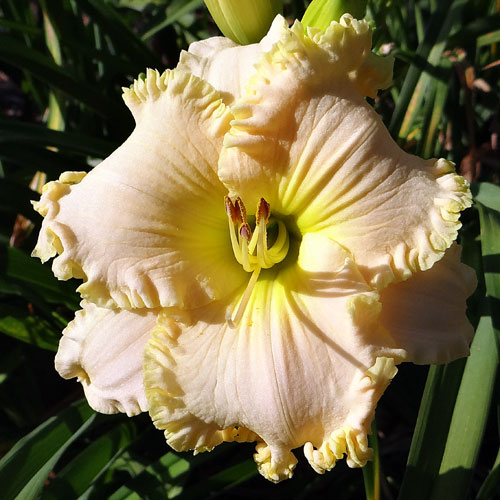
Seedling 05-033
For the past couple of weeks, seedling 05-033 has been outperforming everything else in the garden. While some cultivars putting out a few small or misshapen blooms, 05-033's blooms still look great. It started blooming a little later than usual this year with the FBO on May 23rd. With 30+ buds followed by ample rebloom, it has continued to bloom ever since. It has 6" blooms on 31" scapes and comes from the cross (Victorian Lace X JT Davis).
|
 July 3rd, 2022 July 3rd, 2022 |
While watering the back yard this morning, I saw a neon skimmer dragonfly. I often see dragonflies in the back yard, they especially like to perch on the top of my tomato cages, and usually I pay them no mind. But this one was different as it was so striking. I have never seen these before.
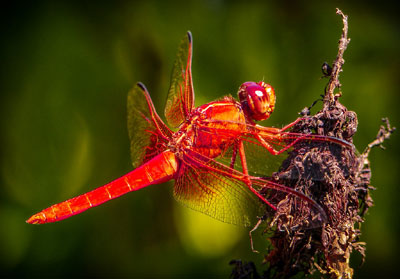
Neon Skimmer Dragonfly (not my pic)
Update: I just came in from moving the sprinkler and this time I saw two neon skimmers!
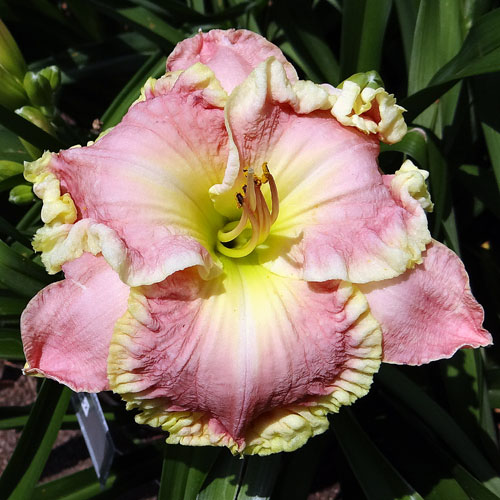
Seedling 16-052
Seedling 16-052 has 6" blooms on 24" scapes and comes from the cross (Celtic Moonglow X Rose Sensation).
|
 June 30th, 2022 June 30th, 2022 |
After giving the matter much thought, I have decided that in order to do the job right, the garden reorganization will have to be completed over a 3 year period. Phase I will begin this fall and involve completely reworking the front yard beds. One of the issues with the current configuration of the front beds is that the different colors are not organized in a way that promotes each individual cultivar. Too many similar cultivars are growing right next to each other and when the clumps get big they tend to meld into each other. Separating like colors will make each stand out on its own. Another problem is that I have a hodge-podge of scape heights from front to back. The tallest scapes should be in the back working toward the shortest in the front. That keeps the short scapes from being hidden in the back of the beds. To accomplish a complete rearranging of the cultivars, the beds will have to be emptied and then replanted. While the beds are empty, the soil will be amended with a generous application of compost. Then the daylilies can be replanted in a new and organized fashion.
The back yard beds will be done over the following two years. The plan is to eliminate many of the lower performing seedlings so that I can spread out the remaining plants giving them better growing conditions.
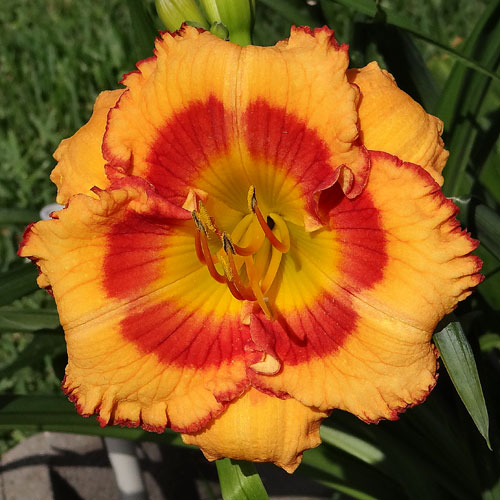
Seedling 15-061
Seedling 15-061 has 5.5" blooms on 29" scapes and comes from the cross (Bella Vita X Frank's Red Hot Tamale). It is a well behaved cultivar, opening fairly consistantly, with a decent bud count.
|
 June 23rd, 2022 June 23rd, 2022 |
If the current heat wave isn't enough, there are now rumors of possible future water restrictions. This caused me to start thinking... is there anything I can do to help the daylilies cope with the situation? Actually, there is one thing that I do every year that will help. Every year after blooming is finished, I like to give the daylilies a little boost by a light application of time-release fertilizer. Along with this, I apply a liquid mix of Humate (humic acid) with a little agricultural molasses and seaweed extract. The main benefit of humic acid for this discussion is that it increases the water holding ability of the soil. There are many other benefits of humic acid but I'll leave those for a later discussion. I'm going to hold off on the fertilizer application for another few more weeks but it's now time to start applying the humic acid mix.
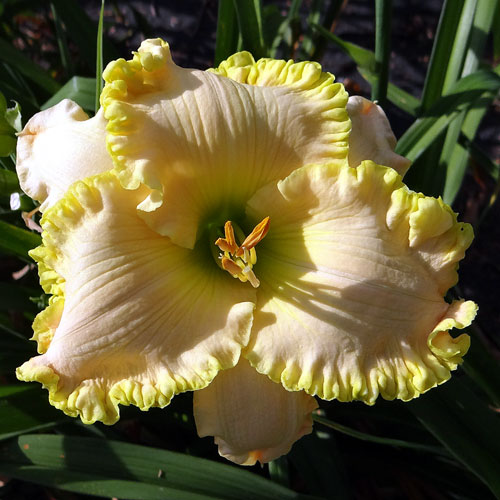
Seedling 14-058
Seedling 14-058 has 5.5" blooms on 24" scapes and comes from the cross (What Love Can Do X Priscilla's Smile).
|
 June 20th, 2022 June 20th, 2022 |
The heat wave continues and is expected to get even hotter late this week (mid 100's). My daily walk around the garden is typically quite short these days. Not because of the heat but because there aren't a lot of good looking blooms. The best blooms seem to be on those daylilies that started blooming later than most others so I guess that's a good arguement for including some lates in my southern garden. These 'lates' are still looking good but the overall die back of the daylily foliage takes the shine of the few good looking blooms.
I tend to hold off on many indoor tasks until the hot weather arrives. I suppose this is kinda like people up north leaving indoor tasks for when the north winds and snow arrive. My garden is still a main focus as I have hundreds of pictures taken during bloom to sort through. I also have numerous video clips to edit and combine into a 2022 garden tour video. I'll post a link here when it becomes available.
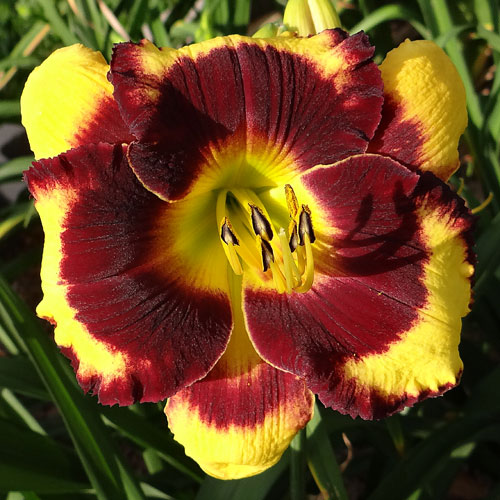
Seedling 15-024
Seedling 15-024 has 5.5" blooms on 26" scapes and comes from the cross (Hedwig's Eyes X Dragon Knife). The intense bright yellow color really stands out in the garden.
|
 June 11th, 2022 June 11th, 2022 |
Temperatures today are expected to reach 100 F. The heat wave of the last few weeks is trying its best to put an end to bloom season. Blooms are smaller and colors faded while many of the outer leaves of the lush foliage of a month ago have yellowed and then dried up. Yes, the daylilies are going into self preservation mode which is normal for this climate albiet a few weeks earlier than usual. The plan is to wait until the summer leaf die-off has completed before I remove all the brown foliage. The garden looks ratty right now but once I get it cleaned up it will look good again.
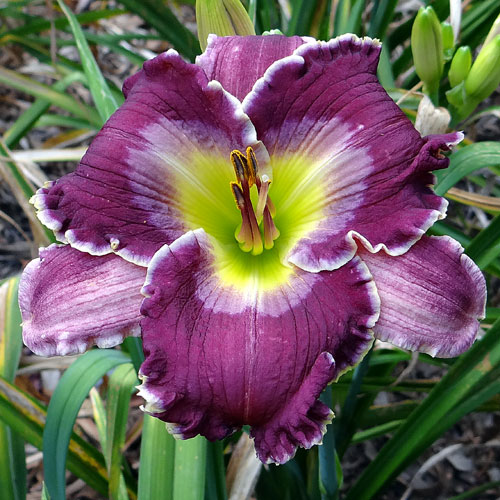
Seedling 13-091
The last two seedlings have now had their FBO (first bloom open). Seedling 13-091 is one of those late bloomers. It has 6.0" blooms on 30" scapes and comes from the cross (Piping Rock X Jennifer Trimmer). Because of the heat, 13-091's blooms have not been at their best this year but typically it's been a good performer with bud counts in the high 20's.
|
 June 9th, 2022 June 9th, 2022 |
While I was removing scapes recently, I found a few proliferations. Prolifs as they're often called appear as leafy shoots growing from nodes along the scape. If left in place they often form roots where they attach to the scape. These when removed and planted can develop into fans that are identical to the originating cultivar (clones). If there are only the beginnings of roots or no roots at all, the prolif can be placed in a little water which can sometimes encourage the roots to form.
I seldom spend any time trying to root prolifs as it can take a little time and effort, both of which I never seem to have enough of. One trick I have used that doesn't involve any effort is to take a prolif with roots and separate it from the scape leaving 3" of scape below the roots and 1" above. The scape is cut at an angle with the bottom part coming to a point so it can more easily be inserted into the soil. I then insert the prolife in the soil right beside the cultivar it came from. I try to place it where it gets the least amount of direct sun. The only effort needed after planting is perhaps a little extra water to help the roots take hold. Because it's right next to the parent plant, if successful, it becomes part of the clump so no record keeping is required.
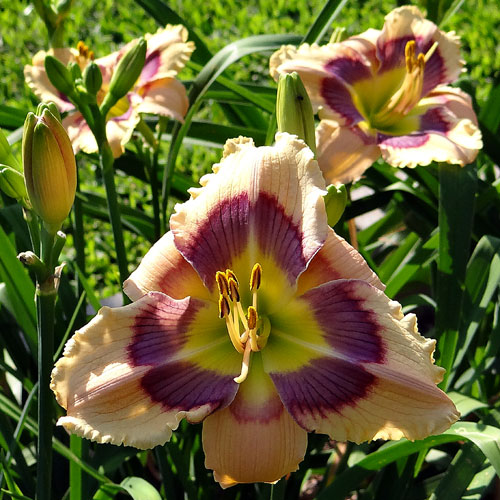
Seedling 07-013
Seedling 07-013 is one where sometimes it can appear to have a lot of blue in the eye. It's not so apparent in bright sunlight but in shade the blue becomes more apparent. It's an oldie for me but I keep it around because I like it. It has 6.0" blooms on 28" scapes and comes from the cross (Web Of Intrigue X Optical Art).
|
 June 5th, 2022 June 5th, 2022 |
A front passed through a couple days ago reducing the humidity levels. This was an ideal time to cut off the spent scapes from the front yard garden. I used to leave the scapes until they were completely dried out. My thinking is that there are a lot of plant juices in those scapes and they will be drawn back into the plant when blooming is finished. Unfortunately, spent scapes detract from the look of the garden so in recent years I've started removing them by cutting them off. I don't think it's wise to just pull them off unless they release with only a slight tug. Forcibly pulling them off too soon can leave an open wound to the plant where they were attached which could allow pathogens a point of attack to a plant that may already be stressed by the summer heat.
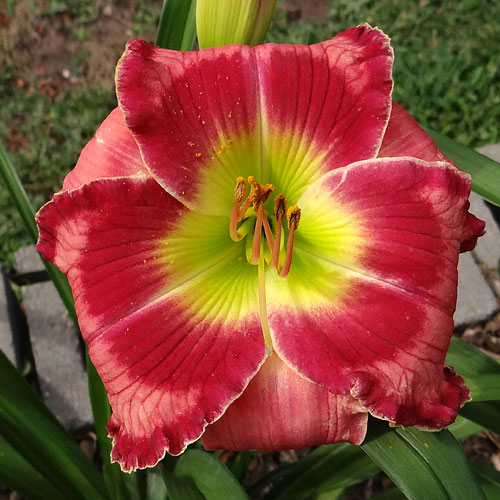
Seedling 16-135
Seedling 16-135 has 6" blooms on 27" scapes and comes from the cross (Calamity Jane X (Wild Cherry Roundup x Walter Kennedy)).
|
 June 3rd, 2022 June 3rd, 2022 |
This morning I had FBO (first bloom open) on two of the remaining four daylilies that had not yet bloomed this year. I don't grow many late season bloomers. This goes back to my hybridizing days. Daylily seed rarely sets when daytime temperatures are above 90 degrees so I preferred crossing early and mid season bloomers so I could set my seed before it got too hot. Using only early to mid season daylilies resulted in mostly early to mid season seedlings but there have been a few exceptions. So I patiently await the last two seedlings to bloom both of which have scapes.
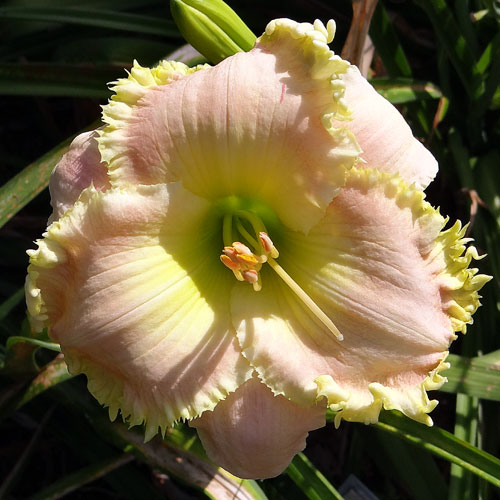
Seedling 08-029
Seedling 08-029 is one of those daylilies that can bloom so well one year that after blooming the fans can be quite small. This usually means the following year bloom is less than spectacular. I keep it around for the good years. It has 6" blooms on 26" scapes and comes from the cross (Sheer Excitement X Zephyr's Song).
|
 June 1st, 2022 June 1st, 2022 |
For some reason, this year the green anole lizards are more tolerant (friendly?) than in past years. It used to be that whenever I got near they would scurry away and hide. This year however, many of them just stand their ground giving me 'the eye'. I was deadheading the other evening and came across one lounging on one of the open flowers. In order to remove the bloom, the lizard had to move but he wasn't having any of it. He just sat their looking at me. So I extended my hand and without any prodding he walked onto my hand. I carried him to some nearby foliage and with a little encouragement, he hopped off. Then just this morning, one was laying right next to a hose I was about to use. He allowed my hand to come within mere inches without flinching. There have been numerous other examples. Maybe it's because I talk to them (LOL).
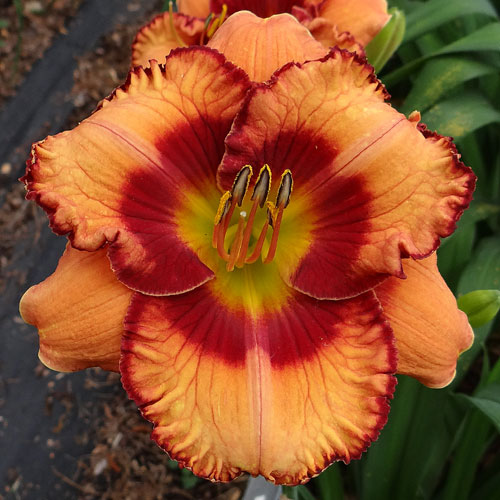
Seedling 15-040
Seedling 15-040 has 5.5" blooms on 26" scapes and comes from the cross (Dragon Knife X Bella Vita).
|
Previous Posts
 Back to current posts>
Back to current posts>
|

 August 29th, 2022
August 29th, 2022 August 25th, 2022
August 25th, 2022 August 19th, 2022
August 19th, 2022 August 12th, 2022
August 12th, 2022 August 10th, 2022
August 10th, 2022 August 7th, 2022
August 7th, 2022 August 5th, 2022
August 5th, 2022 July 29th, 2022
July 29th, 2022 July 23rd, 2022
July 23rd, 2022 July 22nd, 2022
July 22nd, 2022 July 15th, 2022
July 15th, 2022 July 13th, 2022
July 13th, 2022 July 10th, 2022
July 10th, 2022 July 6th, 2022
July 6th, 2022 July 3rd, 2022
July 3rd, 2022 June 30th, 2022
June 30th, 2022 June 23rd, 2022
June 23rd, 2022 June 20th, 2022
June 20th, 2022 June 11th, 2022
June 11th, 2022 June 9th, 2022
June 9th, 2022 June 5th, 2022
June 5th, 2022 June 3rd, 2022
June 3rd, 2022 June 1st, 2022
June 1st, 2022 Back to current posts
Back to current posts























